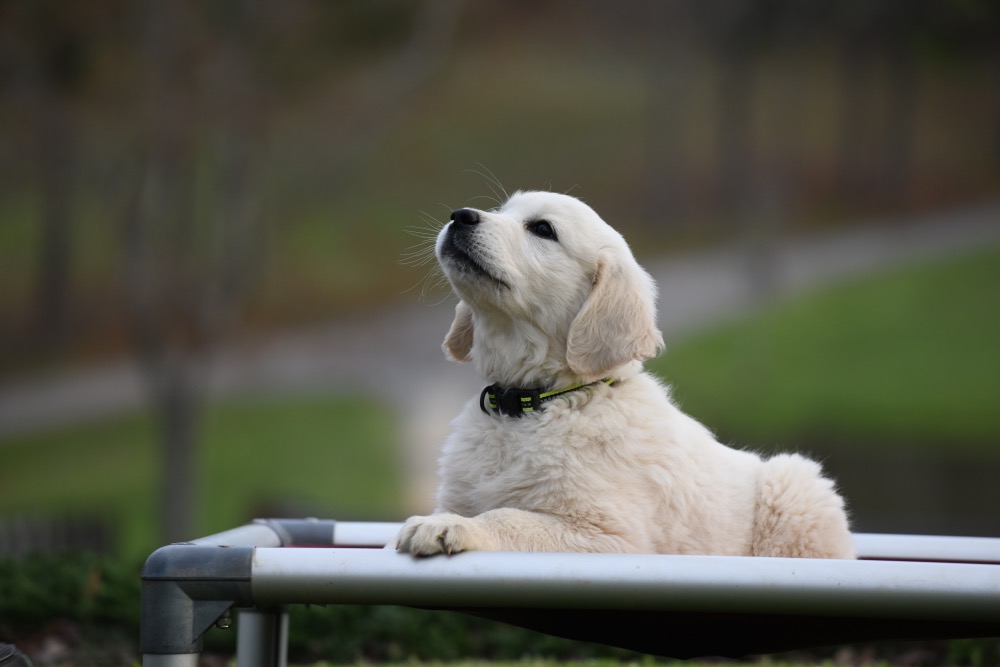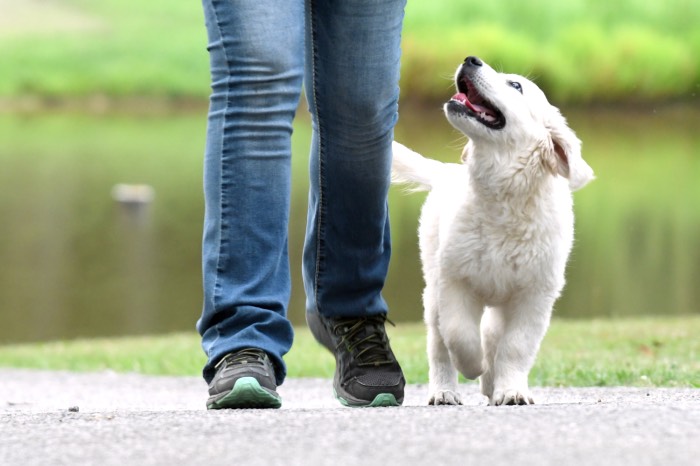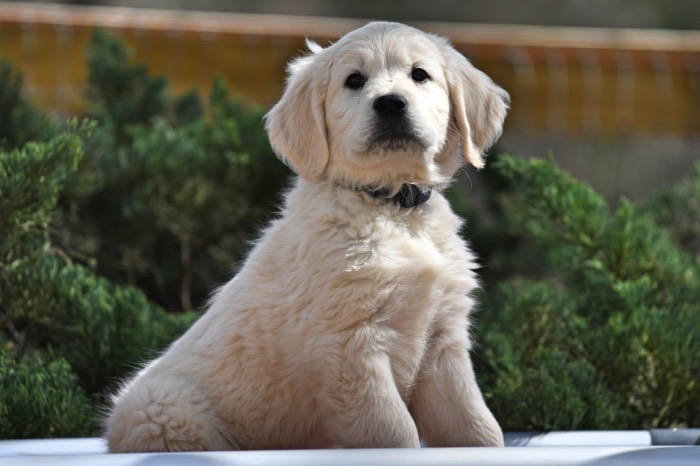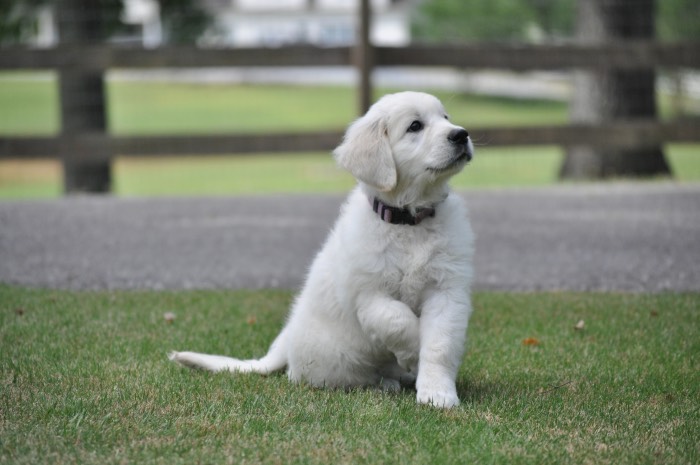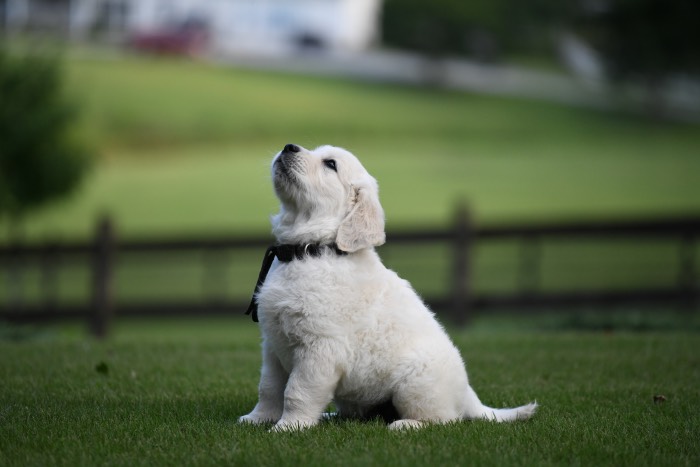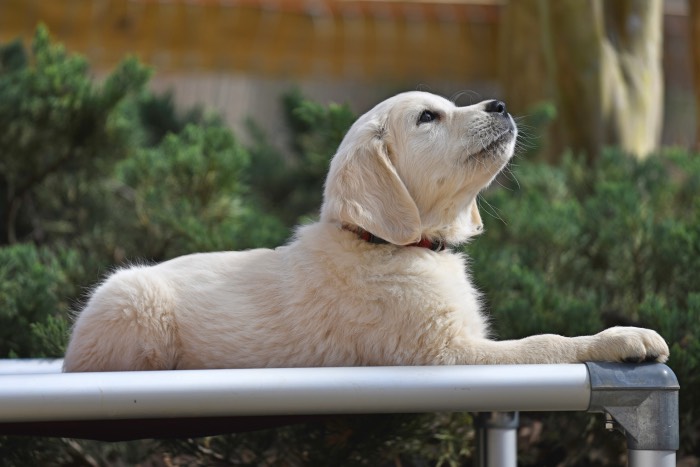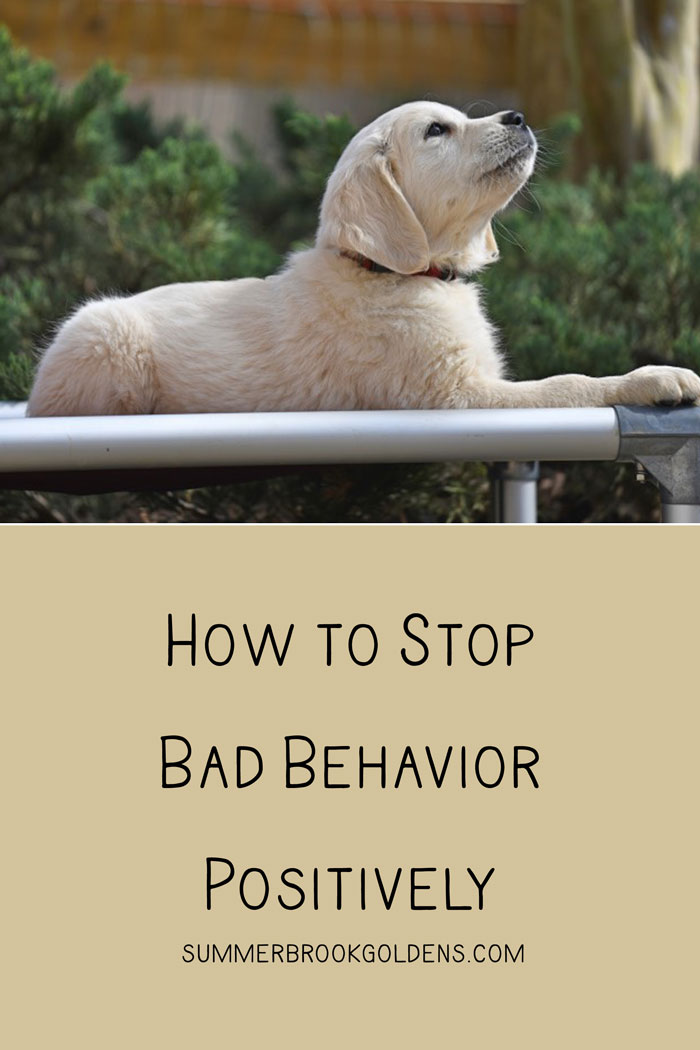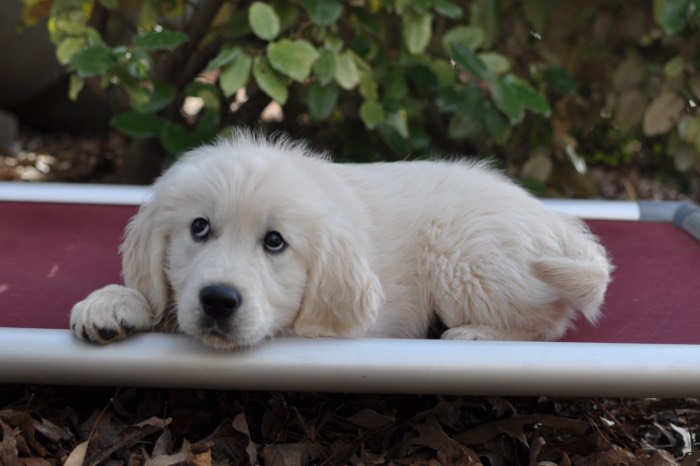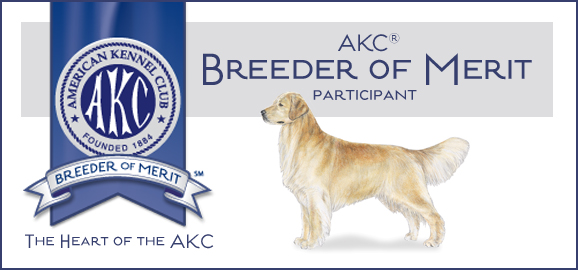Do you want to teach your puppy to have the kind of attention on a leash that the puppy in the picture below has? Notice the vehicle coming up from behind the puppy. This is a major highway with traffic going 55 mph. Cars are flying by and 11 week old Jax is focused on his handler. Read on to learn the“whys” and the “how to‘s” of teaching a puppy to walk on a leash. Leash walking a puppy without his pulling on the leash is possible!
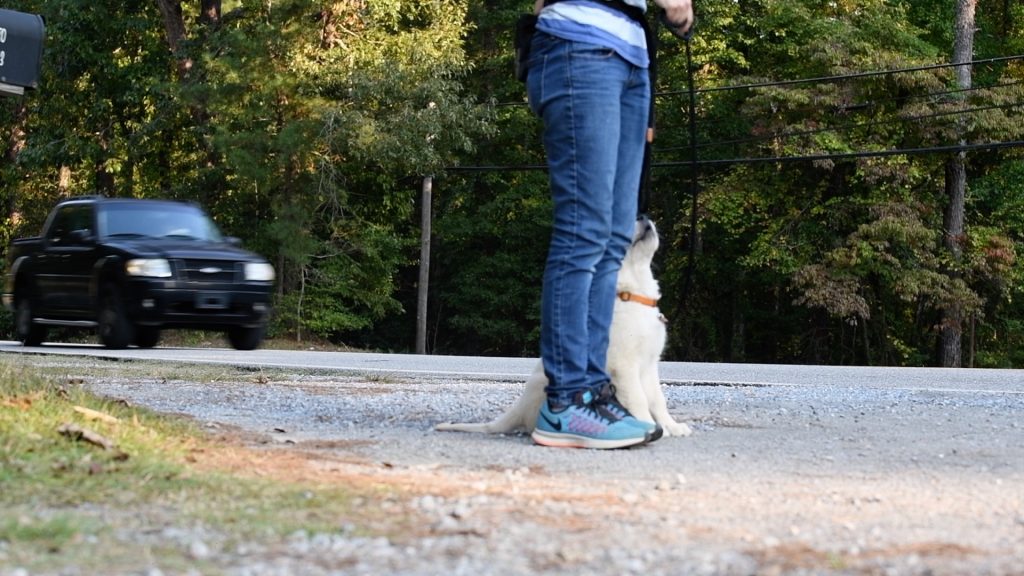
This page was written primarily for families with a new puppy. However, the training process described in this article can be applied to any age dog.
Train and Socialize First
The best way to train a puppy to consistently walk well on a leash without pulling is to lay a good foundation before heading out on a real walk. We teach loose leash walking by way of a 3-step process. The first step involves at home training: in your house or in your backyard. The second step is to take this same training into increasingly distracting environments. And then the final step is to actually walk in one of these environments that you have already desensitized and socialized your puppy to.
The Purpose of the Leash Walk in Young Puppies
The primary purpose of a leash walk for a new unsocialized puppy should be two-fold. First, you need to provide the puppy with socialization experiences and chances to acclimate to new environments or to new sights, sounds, and smells. A second purpose for a leash walk for a new puppy is training.
Leash Walking and Exercise
A leash walk for a new puppy should not be for the purpose of getting exercise. Exercise should not be a part of a leash walking experience until a puppy has developed a level of self-control, been thoroughly desensitized to a particular environment, and been well trained in loose leash walking in that particular environment. See our page on Exercise and the Young Puppy for ideas on how to meet this very important need in your puppy.
Further, for large breed puppies, leash walking is not enough exercise. Large breed puppies need opportunities to run and play. These opportunities need to be off-leash. Runs on a leash are not good for a puppy’s growing joints.
Once over 6 months and your puppy is well-trained and well-socialized, you can slowly add some jogging to your walks. Make sure the jog does not cause the puppy to break a trot and do not over-do it. However, still, your puppy needs time to run off-leash for additional exercise.
The Leisurely Stroll
Also, until your puppy is trained to a certain level, the purpose of a leash walk cannot be for you to enjoy a leisurely stroll. For now, the leash walk will be work. But the work will be worth it! If you put the work in now, your leisurely stroll will be far more enjoyable in the not-so-distant future.
Why Should Your First Priorities be Training and Environmental Desensitization?
A puppy needs to be trained to focus on a handler before he can be expected to remain in a reasonable position with regard to the handler. A puppy also needs to develop a level of self-control prior to being asked to refrain from jerking and pulling when he wants to get to something. In addition, a puppy cannot pay attention to walking in the correct place if the distraction level is too high. Taking a puppy out on the street before training and before socialization and desensitization take place will set your puppy up for failure. Set him up for failure and you’re going to eventually create bad habits. Bad habits are much harder to break than training a puppy right to begin with.
Therefore, the best course of action is to desensitize the puppy to whatever scares him, to gradually build his ability to handle distractions, to teach him to focus on you, and to gradually build his self-control before you ask him to go on a walk without training as your main priority.
Further (and most importantly), it is important to concentrate on socialization and environmental desensitization early in the process. This is the most important part of raising a puppy under 16 weeks of age.
The Socialization Period
You will have a window of opportunity for this very important part of raising your puppy that slowly closes at around 16 weeks of age. If you miss this opportunity, your puppy will not grow up to be as confident as he would had he been properly socialized early in his life. You can make up for this time later. However, it will be much more difficult.
How to Move Through the Steps of Our Leash Training Program
The training in each of the steps of this program is never meant to be perfect. You need to reach a certain level of training which will be discussed below before moving to the next step. However, you will never be completely done with any step. You need to continue working your puppy on not only the training step that your puppy has reached, but also on the previous steps.
Step 1: Preliminary Work at Home
Working on step 1 includes work in 5 different areas. First you should be building your puppy’s desire to work with you. Second, you should be teaching your puppy behaviors that he can perform while on leash. Third, you should build self-control in your puppy. Fourth, you need to teach your puppy to focus on you. Fifth, you need to build confidence in your puppy. You can work in all five of these areas simultaneously.
This work should initially take place at home where there are virtually no distractions. A backyard works well for most.
Step 1 If You Have a Summer Brook Puppy
If you have a Summer Brook 10-11 week old puppy, we will have worked with your puppy to where he will have practiced on step 1 more than enough to move to the desensitization step if I were continuing the training here. Our 12 week old puppies will already be working in step 2 (desensitization to the environment).
However, no matter the age you picked up your puppy, you need to acclimate your puppy to you and your home first. Therefore, you need to work in step 1 by practicing what we’ve already taught your puppy in your backyard before moving to step 2. Working in your own yard on step 1 for one or two days should be sufficient before move on to step 2.
Step 1 If You Do Not Have a Summer Brook Puppy
If you do not have a Summer Brook puppy, begin step 1 by teaching your puppy his first behavior. This behavior should be maintaining eye contact while he sits still. If you teach this using marker training and shaping, you will not only be teaching your puppy a new behavior, you will also be working toward achieving the other four step-1 goals at the same time. Your puppy will be learning to focus on you, to have self-control, to develop self-confidence, and to love working with you.
After you teach your puppy to maintain eye contact, teach him a simple hand touch and to sit at your side and stay there. Sitting still will build self-control. A hand touch can be used to guide your puppy back to the correct position when he gets out of position.
Why Build Focus, Self-control, Confidence, and a Desire to Work with You First?
Paying attention to a handler is essential for success in loose leash walking. Dogs who are well-trained at walking on a leash may appear to be looking around at their environment while they just happen to remain in sync with their handler. However, these dogs are still keenly aware of where their handler is, even if it is only with peripheral vision.
This keen awareness of a handler with peripheral vision alone must be trained. Focus needs to be trained so well that a puppy can eventually maintain good focus on the handler while he is focusing on two things at once: the world around him AND his handler.
Building Internal Qualities Should be Priority
Building a love of working with a handler and focus go hand in hand. It is this love of working with you that will give your puppy the motivation to remain focused on you.
Self-control is necessary as you encounter various distractions on a walk. Without self-control, a dog will tend to react to every new distraction that comes along.
Self-confidence is necessary so that your puppy is not afraid of every new thing that you pass on a walk.
Developing these qualities in your puppy is important in every aspect of a puppy’s life, including walking on a leash.
Step 2 in Teaching Leash Walking to a Puppy: Moving Out Into the World
Don’t Forget to Continue Working on Step 1 Training After you Move Up to Step 2
Once you’ve trained your puppy to sit still with eye contact and to do a hand touch, and when your puppy is actively trying to get you to work with him, you can work your puppy on step 2 during the same time period as you’re continuing working with him at home (step 1).
However, don’t stop step 1 work. After you’ve trained your puppy to sit beside you giving eye contact and to do a hand touch, train other behaviors as well. Train your puppy to do a down and to stay there while you back away from him and return. Teach him to go from a down position in front of you to a sit position beside you. Train him to move from your side back to in front of you. Teach him to spin. Ideally, you will also teach your puppy to heel. Do all the initial teaching at home. Then take the training out into the world.
Prepare for the Walk
Before you begin your first walk on a leash, do the following:
- Make sure your puppy does not have an over abundance of energy. Get him some form of exercise before you leave. See our page on Exercise for some ideas.
- Make sure your puppy is hungry. You will be using positive reinforcement training. For this type training to work, a puppy needs to want whatever you are reinforcing with. We suggest you initially use food. If you’re puppy is full, he won’t be motivated to work for the food.
- Put some food in a treat bag and snap it on your waist. I suggest taking the puppy’s entire meal with you. If you don’t use it all, feed the rest to him when you return. Our young puppies who are not overweight or over fed will work for dog food kibble.
- Put a correctly fitting collar on your puppy. See our upcoming page on collars for more information. Attach a 6 foot leash.
Where to Teach Your Puppy to Walk on a Leash
This second step in teaching loose leash walking is to let your puppy acclimate to new and different environments. Start with the most familiar environments. Gradually over time, acclimate your puppy to more and more distracting and possibly scary environments. On the first day of working away from your back yard, move to the front yard. Then you can take your training on the road getting a little further from your home with each session.
After your puppy is working consistently well in a particular environment, it’s time to move to another one. Always keep your puppy’s ability to adapt to stressful and/or stimulating situations in mind as you consider where to go. Don’t increase the stress level or distraction level too much.
Consider stores and public places. I love to go to parks, Tractor Supply, Home Depot, Lowes, Michaels, and Hobby Lobby to name a few places that welcome dogs. However, don’t go to pet stores or dog parks or any other place with large numbers of possibly unvaccinated dogs until your puppy is fully vaccinated.
Vaccines and Puppy Socialization
It is more important that you get your puppy out and socialized prior to his being 16 weeks than it is for him to be fully vaccinated. The risk for future damage to a puppy’s confidence is greater than the risk of disease. Stores with relatively few dogs are very low risk for a puppy who has had at least one vaccine when he was over 9 weeks. Wait at least 6 days after the vaccine was given before leaving your home. Vaccines for Parvo and Distemper are all you need.
How to Start Step 2
Take your puppy to the selected spot for environmental desensitization. Let your puppy sniff around and interact with his environment until he is comfortable.
Once he’s sniffed around a bit and acclimated to his new surroundings, he should either sit and stare at you or begin offering different behaviors in order to get you to work with him. When your puppy begins showing interest in working with you, oblige him and give him the opportunity to earn his food.
If your puppy doesn’t look to you to work, you need consider the following. Have you adequately prepared for the walk. Look at the section above on preparing for the walk. You also need to make sure you have adequately built a desire to work in your puppy at home. Thirdly, evaluate the environment. Is it too distracting?
Continuing Step 2 With the Summer Brook Puppy
When your puppy looks at you wanting to work, do the following if you have a Summer Brook puppy. Say “right here” and point behind you to cue him to get in heel position. Begin heeling and marking and rewarding. The more distracting the environment, the more often you’ll need to reward your puppy to keep his attention.
No matter how comfortable the environment is to the puppy, you need to reward often. When in step 2 or our program, reward often. Rarely go more than 10 steps without rewarding. Never go more than 14 – 16 steps without rewarding. Reward your puppy often for just sitting in heel position. Take one step and reward. Occasionally take two or three. Sometimes take ten. Make sure the rewards are coming randomly. Don’t be predictable. To maintain good focus, a puppy needs to think that the reward could come at any time.
If your puppy is consistently loosing focus and you are sure that he is completely comfortable with the environment, you may not be rewarding often enough or your rewards may not be random and always coming at the same time (after about the same number of steps). If your puppy thinks that the reward will always come after 6 steps, he will quit looking at you until just before the sixth step.
It is important that you reward occasionally after one step. If you don’t, he’ll start the walk by looking at something else until he thinks it is possible to get the reward. Then something else might catch his eye and you will have more than a momentary loss of attention.
Continuing Step 2 With the Non-Summer Brook Puppy
If you don’t have a Summer Brook puppy and your puppy doesn’t know the “right here” command or how to heel, simply mark and reward for what your puppy does know. As he sits and gives eye contact, say “yes” and give him 3 or 4 pieces of kibble. Move forward a bit and as your puppy follows you, ask him to sit again. Mark and reward repeatedly as your puppy sits still and maintains eye contact. If your puppy maintains eye contact while he is moving, reward him.
It doesn’t matter what your puppy is doing as long as he is actively working with you. You could have taught him any behavior in Step 1. The goal is to teach your puppy to be confident enough in any (and all) environments to be able to focus on and work with you doing something.
Loose Leash Walking in Overstimulating or Scary Environments
When the environment is brand new, make sure you reward often. (This is why you need an entire meal in your training pouch!). If the environment is especially challenging, spend your entire walk time heeling back and forth in essentially the same place or working on a stationary exercise that your puppy knows.
When something new happens, your puppy will probably loose focus on you. This is normal and what I’d expect. Let the puppy experience it as he wants. Don’t make him work until he initiates working with you again. If you’ve accomplished your step 1 goals, he will want to work with you as long as he is comfortable with his surroundings.
If your puppy is distracted or uncomfortable, know that every puppy needs to acclimate to new surroundings. Some might need to get over fears. Others might need to practice self-control if the new surroundings are highly stimulating to him.
Either way, let your puppy interact with the newness in whatever way possible to acclimate your puppy to it. If it is safe, let him sniff the scary thing. Your goal in acclimating your puppy to the environment should be to get him to the point where he chooses to ignore it in favor of interacting with you.
Let the Scared Puppy Fully Experience Whatever Is Scaring Him at His Own Pace
If the puppy is scared, do not do what I’ve seen many trainers recommend: distract him with food. Your puppy does not need to ignore what is scaring him. He needs to fully experience it and process it. If it is something that can be smelled or touched, let him do it at his pace. If it is a sound, let him stop and listen. For more details, see our page on Environmental Desensitization and Socialization.
Yes, your eventual goal is for your puppy to have the confidence to focus on you while ignoring the environment. However, until a puppy is no longer scared of something, ignoring it is simply postponing acclimating to it. Confidence comes from facing fears and learning that they are safe to be ignored.
Don’t Try to Lure a Scared Puppy
If your puppy is scared of something, do not pull or cajole or try to lure your puppy toward the scary thing. Also, don’t get so close to something scary that your puppy tries to pull away from it. Remain at a distance whereby your puppy can comfortably acclimate to it and will quickly re-engage to work with you. See our page on Puppy Socialization for more information on socializing puppies to people, things, and sounds.
Let the puppy experience the new things on his own terms and let him be the one that initiates your working together. If your socialization experience is successful, your puppy will acclimate to whatever scared him and try to re-engage you to work with him. If he doesn’t, you are too close to whatever is scaring him. Move a little further away until your puppy feels safe enough to want to work again. Gradually move closer (which could take minutes or days). Don’t rush this process.
At some point, your puppy will re-orient himself toward you. Begin working with him again. Your work can be heeling. It can be working on a stay exercise.
Anticipate Scary Things
As best as you can, anticipate what might be scary to your puppy so that you can prepare him for it. For example, let’s say your puppy has never experienced a loud truck. You see one is coming down the road. Make sure your puppy is facing the direction the truck is coming from. You don’t want anything scary coming up behind your puppy. Don’t ask your puppy to do anything difficult such as heeling. Instead, simply have your puppy sit and look at you in such a position that he can easily see the truck approaching.
If the puppy is able to maintain eye contact, he is ready for a more difficult distraction. For example, the puppy in the picture at the top of this article is sitting maintaining eye contact while a vehicle approaches from his rear. We set him up for this distraction after he was well desensitized to vehicles approaching from the front. We knew he was ready for this level of distraction. Had the vehicle been an 18-wheeler or a truck pulling a clanging trailer, we would have made sure, the puppy was facing it. If you aren’t sure if your puppy is ready for a certain level of “scariness”, err on the side of caution. Let your puppy face anything potentially scary to him.
Let your puppy decide if he wants to work with you or if he needs to look at the truck. Always let your puppy initiate the starting or the stopping of work while you are in the desensitizing stage of leash training.
Leash Walking a Puppy That Ignores You
When first going into a new environment, your puppy will probably ignore you. This is a normal and healthy part of the process. Your puppy needs to interact with, process, and acclimate to what is going on around him.
However, if you can tell that your puppy is totally comfortable with the environment and he is ignoring you for long periods of time just to entertain himself with sniffing or pulling, you need to go back home and do more groundwork.
There are several possibilities for the problem. Maybe you have not made the training fun enough for him. He might have too much pent up energy. You might not be rewarding often enough. Your rewards could be too predictable. The puppy may not be hungry enough to want to work for you. I cannot stress enough that a puppy that is over fed will not be inclined to work for food. See our page on How Much to Feed Your Golden Retriever.
Where to Practice Loose Leash Walking With a Puppy
As has been discussed, you should begin taking your puppy and working with him in the environments that your puppy feels the safest and is the least distracted in. As your puppy begins to feel comfortable in more and more situations and as he learns to work under more distractions, it’s time to stretch your puppy and expose him to more stressful and highly stimulating environments.
Make sure that the difficulty of the environment is not increasing too fast. If your puppy is too afraid to eat or if your puppy is so distracted that he is excitedly pulling at the leash, you need to leave that environment and go some place where your puppy is less scared and less excited and distracted. If your puppy is overly excited, also consider if your puppy has had enough exercise prior to arriving at your training destination.
Step 3: The Pleasure Walk
When to Start the Pleasure Walk
I recommend continuing the socialization and training leash walks on a regular basis at least until a puppy is over 4 months. These types of walks need to be a priority and be the majority of your puppy’s walks during these early impressionable weeks of your puppy’s life. For my own puppies, I wait until 4 months before taking what I call “pleasure walks”. There is just so much socialization work that needs to be done early, that I prefer to delay pleasure walks. However, it is okay to start pleasure walks earlier as long as you are only walking in places where the puppy is thoroughly acclimated and socialized.
However, on-leash walks can be an enjoyable activity for both a human and his dog. Therefore, let’s talk about how to have a well-mannered leash walking older puppy.
How to Transition from the Socialization Walk (Step 2) to the Pleasure Walk (Step 3)
If you’ve done a good job with your early training, transitioning to this new type walk should be easy. Start your Stage 3 walk without getting your puppy in heel position. Simply, start walking in the direction you want to go. There needs to be clear communication to your puppy as to your expectations. He needs to understand that when you say “right here” and point behind you, you are playing the heeling game. When you move forward without saying “right here”, your puppy should know that he is free to look around while moving.
Your First Pleasure Walk
The first time you start the “pleasure walk”, your puppy will think that you are wanting him to work with you and maintain focus. That’s okay. Praise him for his effort. However, remember that in Stage 2 heeling, you never ask the puppy to heel for more than 14-16 steps before being rewarded. However, for this walk, you will be taking far more than 14-16 steps.
What happens in the puppy’s mind when his reward doesn’t come? Give your puppy verbal praise. If he’s now tall enough for you to pet him under the chin and on the side of his face, pet him. Keep walking at a brisk pace. Eventually your puppy will give up on getting a food reward or something will distract him and he’ll look away. When this happens, don’t react in any way whatsoever. Don’t break your stride. Keep walking.
Many puppies will continue looking up at you for a long time. Many will trot or walk along for awhile looking forward and then look back up at you. Verbally praise them and pet them. I will often pet for as long as the puppy is looking at me (unless they look up so long that my arm tires).
Verbal Praise
The better your work in stage 2, the more your puppy will have become conditioned to enjoy looking up at you while you walk. I am a jogger and my Sydney will look up at me without looking away for over 1/4 mile. She’s done this since she was 6 months old. I don’t even take treats with me. She’s working for the love of the work and for my praise. Good positive reinforcement training will condition a real love for working!
Though this is possible, don’t be disappointed if your puppy is less enthusiastic. Most of the dogs I’ve trained will look forward and all around them most of a walk or jog. They will look up at me sometimes for 20 or 30 seconds while I praise them. When I get tired of praising and look away from them, they look back toward where they are going.
If you are jogging, the movement is the puppy’s reward. Dogs and puppies alike enjoy a slow jog. If you are out for a leisurely stroll, give your puppy a “sniff” break as a reward for good behavior while walking.
Jogging When Leash Walking a Puppy
If you’d prefer these pleasure walks to be a slow jog, that is fine as long as the puppy is over 6 months of age. However, prior to a dog’s growth plates closing, jogs need to be limited to a pace where the dog doesn’t break a trot. Forced running should not be part of a young dog’s life. Running is a good form of exercise, but not for the young dog on a leash.
Growth plates close at different ages, according to the size of the dog and the breed. Golden Retriever growth plates generally close somewhere around 18 months of age. Larger breeds can sometimes take up to or sometimes over 2 years to close. Smaller breeds usually close sooner than 18 months. If you are unsure, your vet can take an x-ray of your dog and they can tell you if your dog’s growth plates have closed.
Don’t Stop Stage 2 Training
Until your puppy is so well desensitized to your environment, don’t hesitate to go back to a Level 2 walk to desensitize your puppy. Take your treat bag with you when first beginning stage 3 walks in case there is a big distraction or something scary.
As your puppy becomes more proficient at ignoring his environment, you can begin spending less and less time in stage 2 (desensitization) training. You can gradually eliminate the treats to where there will be none. Instead the dog’s reward will become simply opportunities to sniff as well as the enjoyment of the walk itself.
Problems in Loose Leash Walking
The Puppy Who Won’t Move Forward
Most puppies will happily follow along with you. If your puppy does not, you need to ascertain why. Usually the problem with a puppy that won’t move is fear. If your puppy is scared or unsure, go back to socializing your puppy to this particular place. If he isn’t moving because he simply doesn’t like to walk, then you need to go back to your socialization walks and make them more fun. For whatever reason, if your puppy doesn’t want to go with you, you need to fix whatever the problem is. Don’t make the puppy go with you by pulling him or popping the leash. Certainly don’t yell at him. You need to make walks a pleasant experience or you will be setting your puppy up for a lifelong battle over leash walking.
The Puppy Who Moves Ahead of You
It would be nice if your puppy would stay perfectly in heel position. However, he probably will not. Most puppies tend to want to walk in front of you. Therefore, you need a plan. You need to set criteria with regard to what position is acceptable and what position is not. Pulling on the leash is never acceptable.
However, I recommend setting the bar higher than simply not pulling. Teach your puppy that he cannot be more than a third of a body-length ahead of you. Once a dog gets further ahead of you than that, he can no longer see you with peripheral vision. He will no longer know where he is in relation to where you are. If he can’t see you, he will inevitably hit the end of the leash.
When your puppy gets more than a third of a body length ahead of you, say either “uh uh” or “no”. Speak in a matter of fact voice. Do not have a tone that communicates anger or sternness. Your goal is not to punish, but rather to give information. Step back one or two steps, point behind you, and tell your dog “right here”. If your puppy doesn’t know the “right here” command, simply wait for him to get himself back in position.
Wait for your dog to get in the correct position before moving forward again.
Teach Your Older Puppy to Back up on Command
I like to teach my dogs to back up. Once learned, it is easier for your dog to back up than to turn around to get back in position. We don’t teach our young puppies to back up because most puppies under 12 weeks are physically unable to coordinate their rather clumsy bodies to walk backwards. Therefore, we teach all our young puppies to turn around and walk back into position and then turn themselves back around. However, by four months of age, most puppies can be taught to back up.
Your First “Pleasure Walks”
Your first few “Pleasure Walks” will probably be more training than pleasure. You’ll spend a lot of time going backwards and forwards. However, dogs learn quickly that it is easier and more fun to keep an eye on you so that they can stay in position than to constantly be backing up. However, dogs do get excited and forget when they see something that is highly stimulating. It will take some time for the learning to become solid enough for the dog to remain in position in spite of distractions.
Distractions When Teaching Loose Leash Walking
Pleasure walks need to be started in low distraction environments. The level of distraction should increase slowly. Increase the distraction level too quickly and you will go back to spending considerable walk time going backwards.
Don’t to Forget to Praise Your Puppy
If your dog is doing especially good, praise him. Dogs love to be talked to. You can also reward him by giving him a break to sniff around and just “be a dog”. Make it fun!
See our blog post on Loose Leash Walking With Positive Reinforcement for more information.

